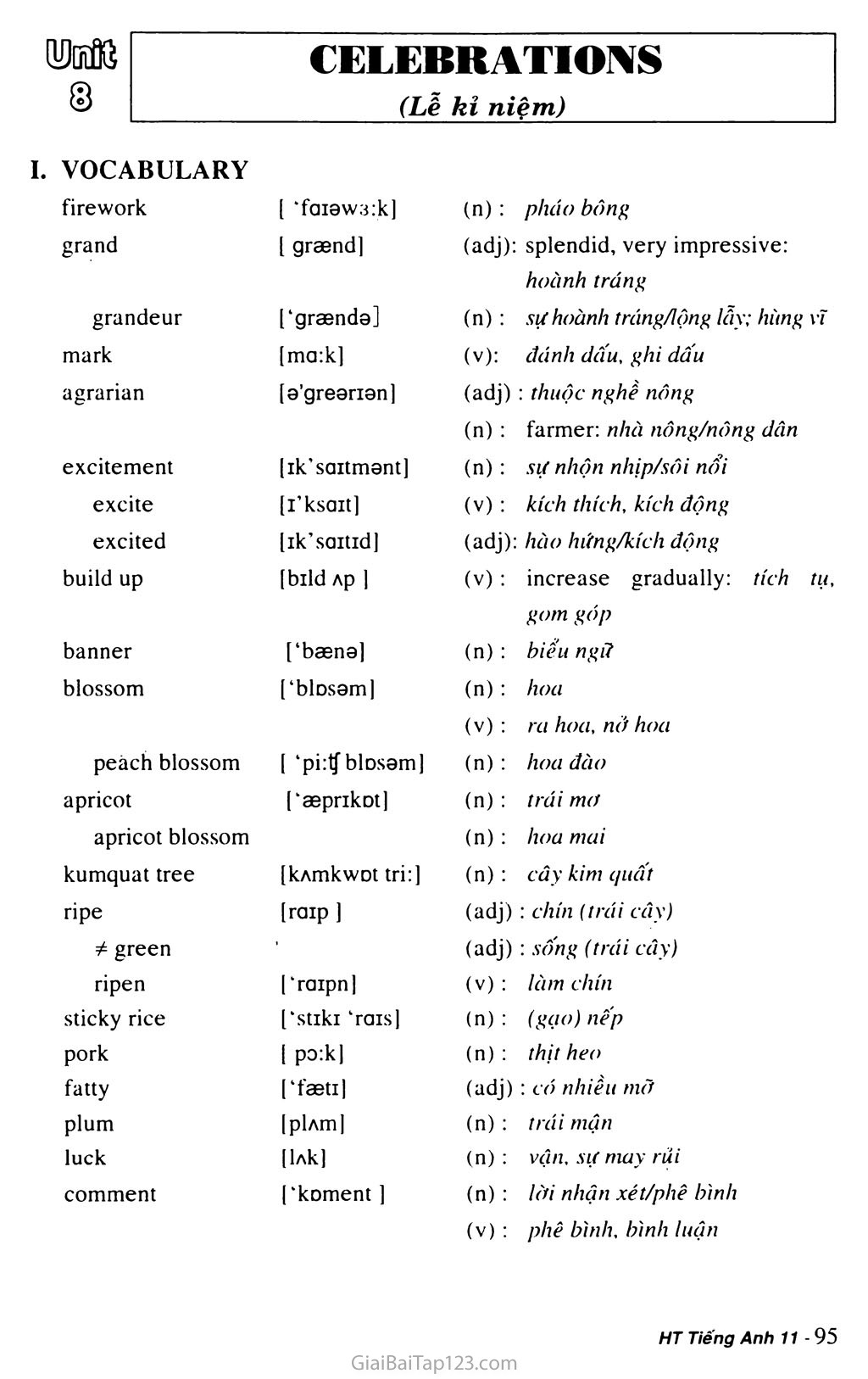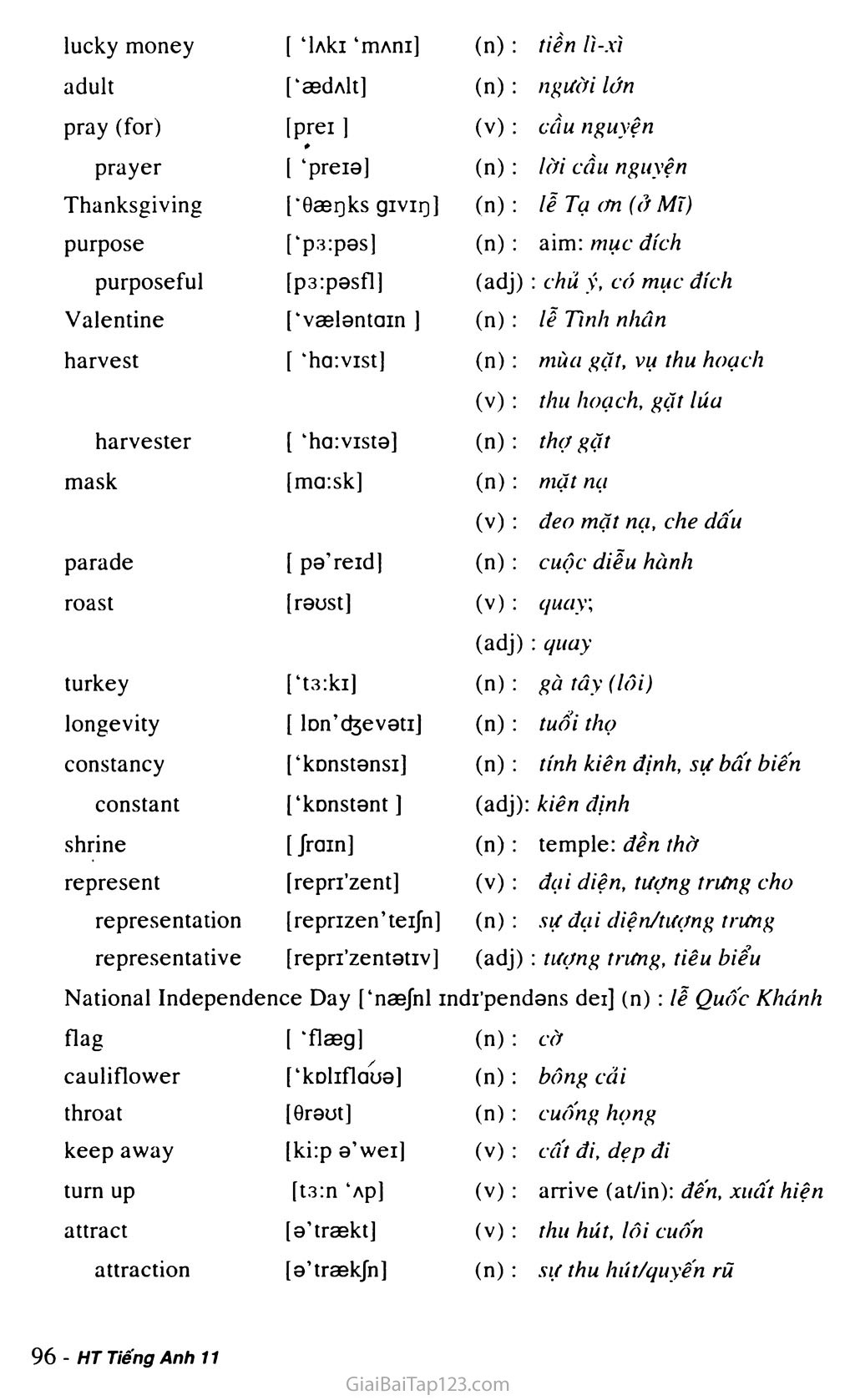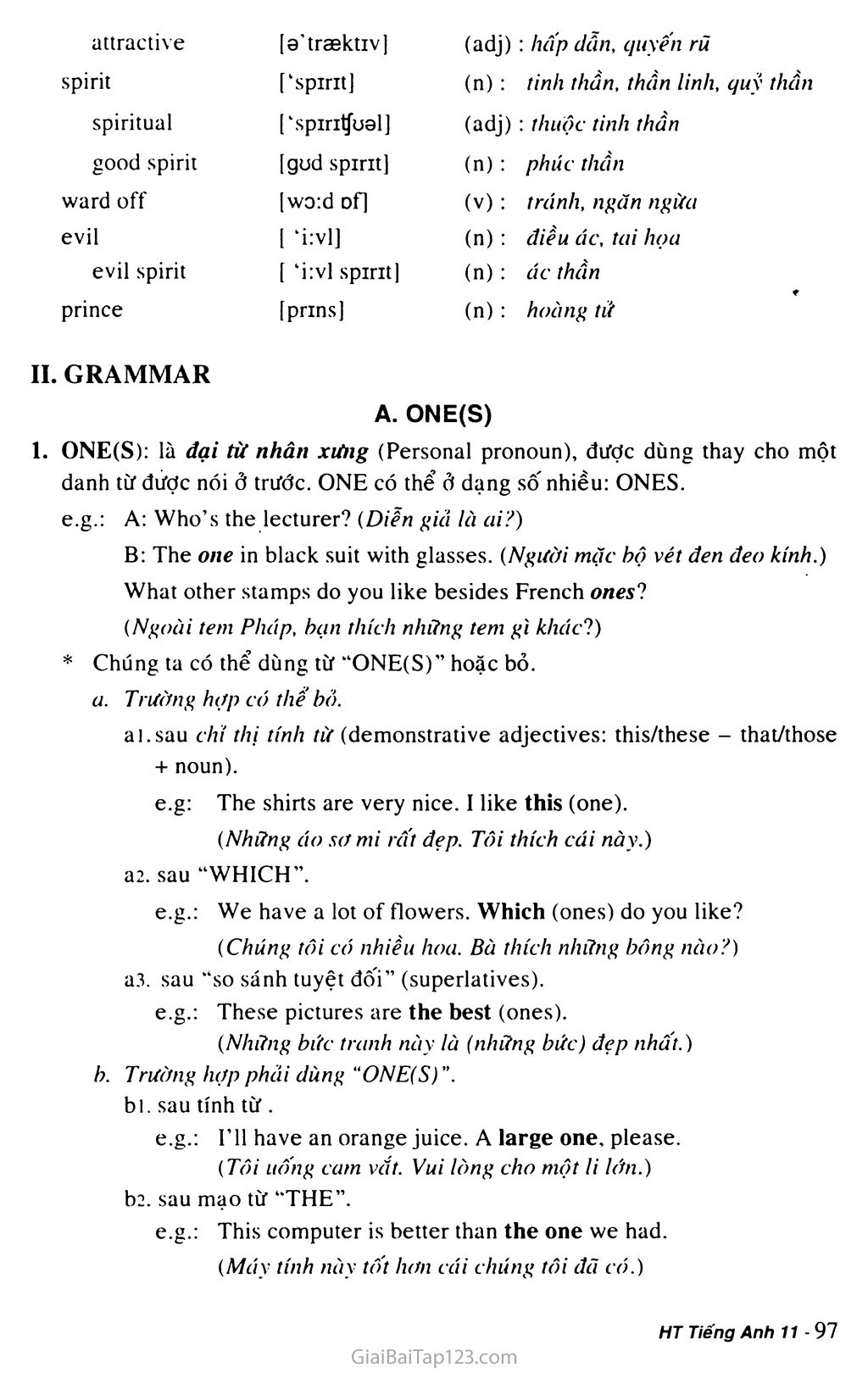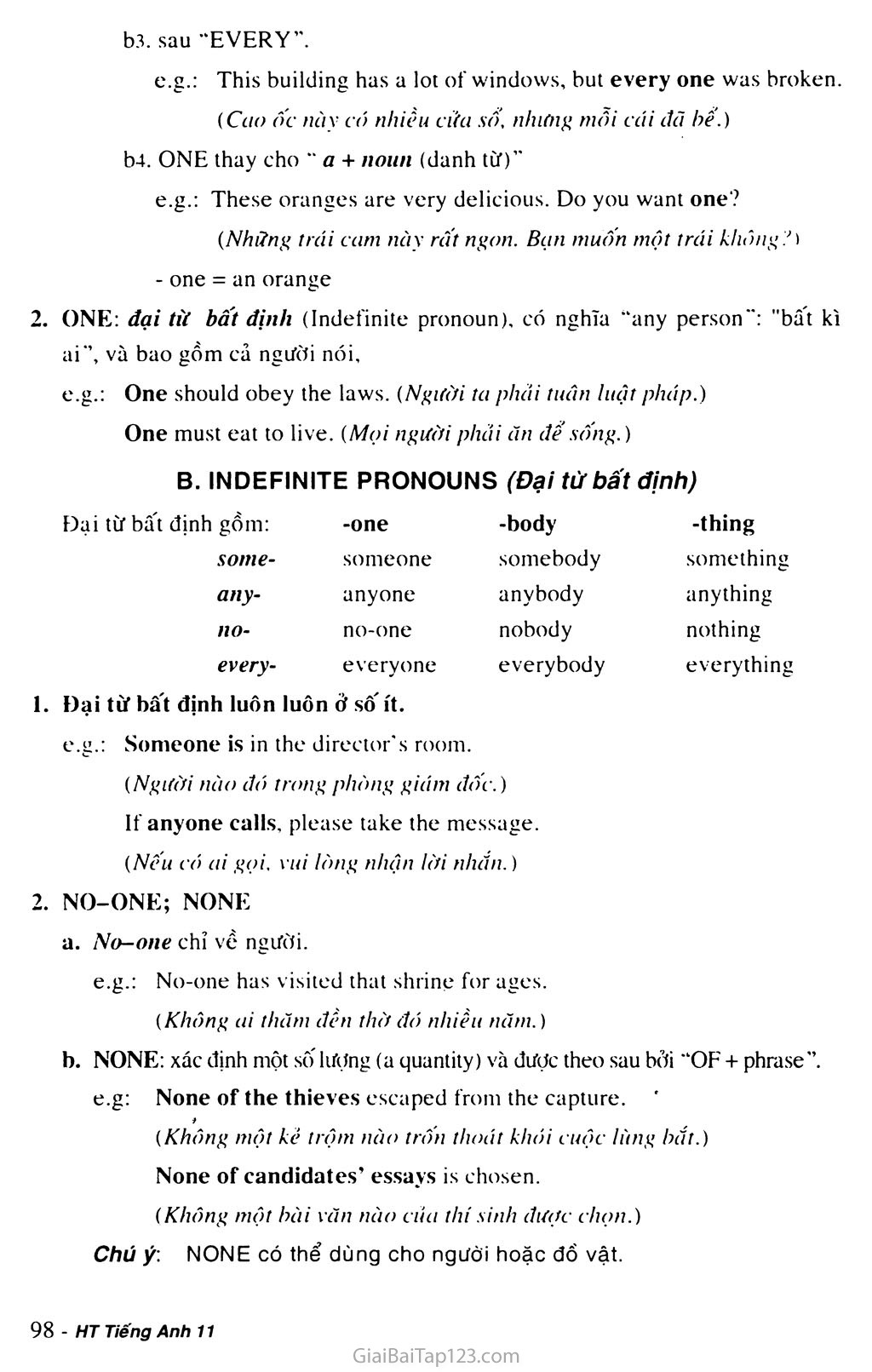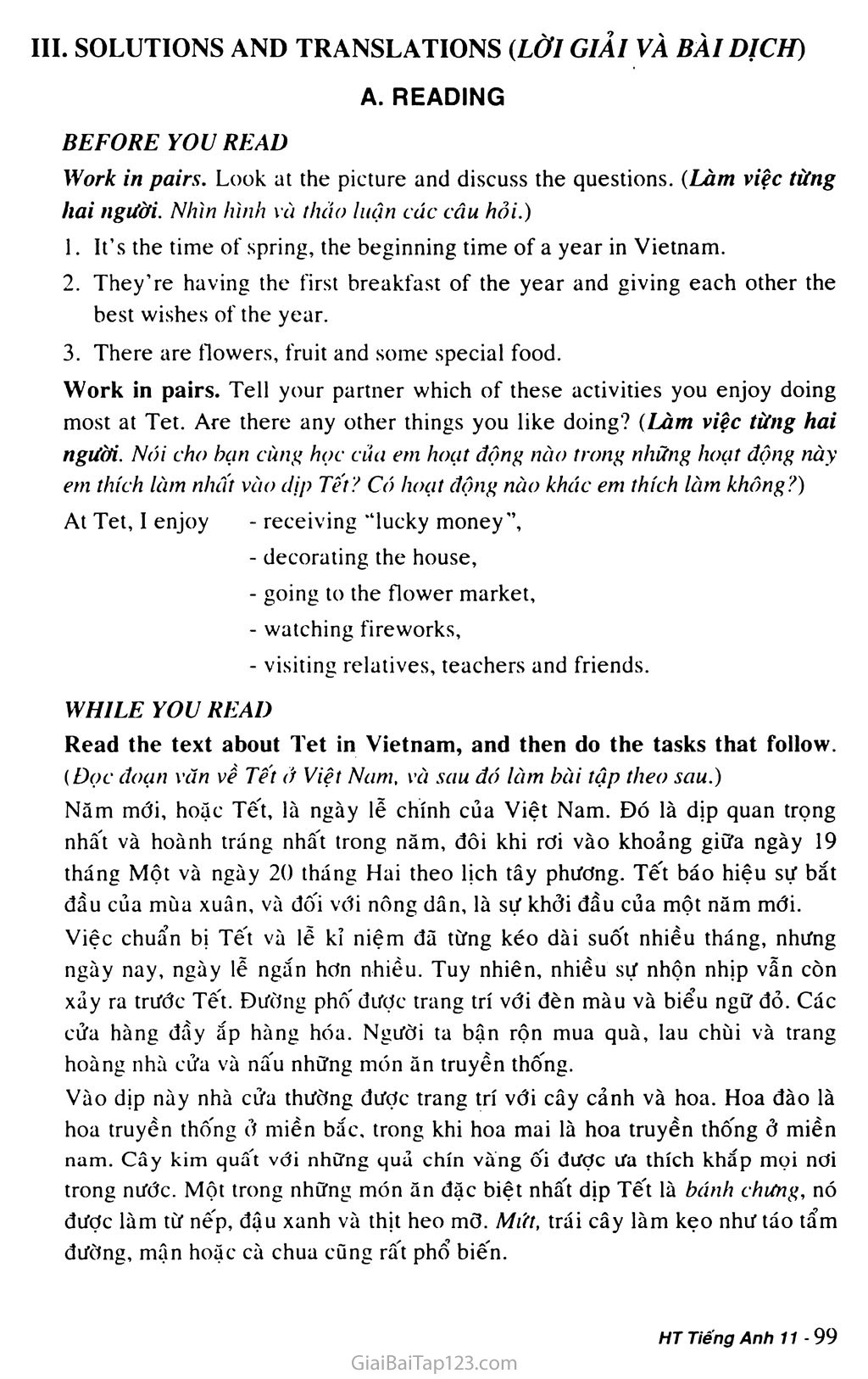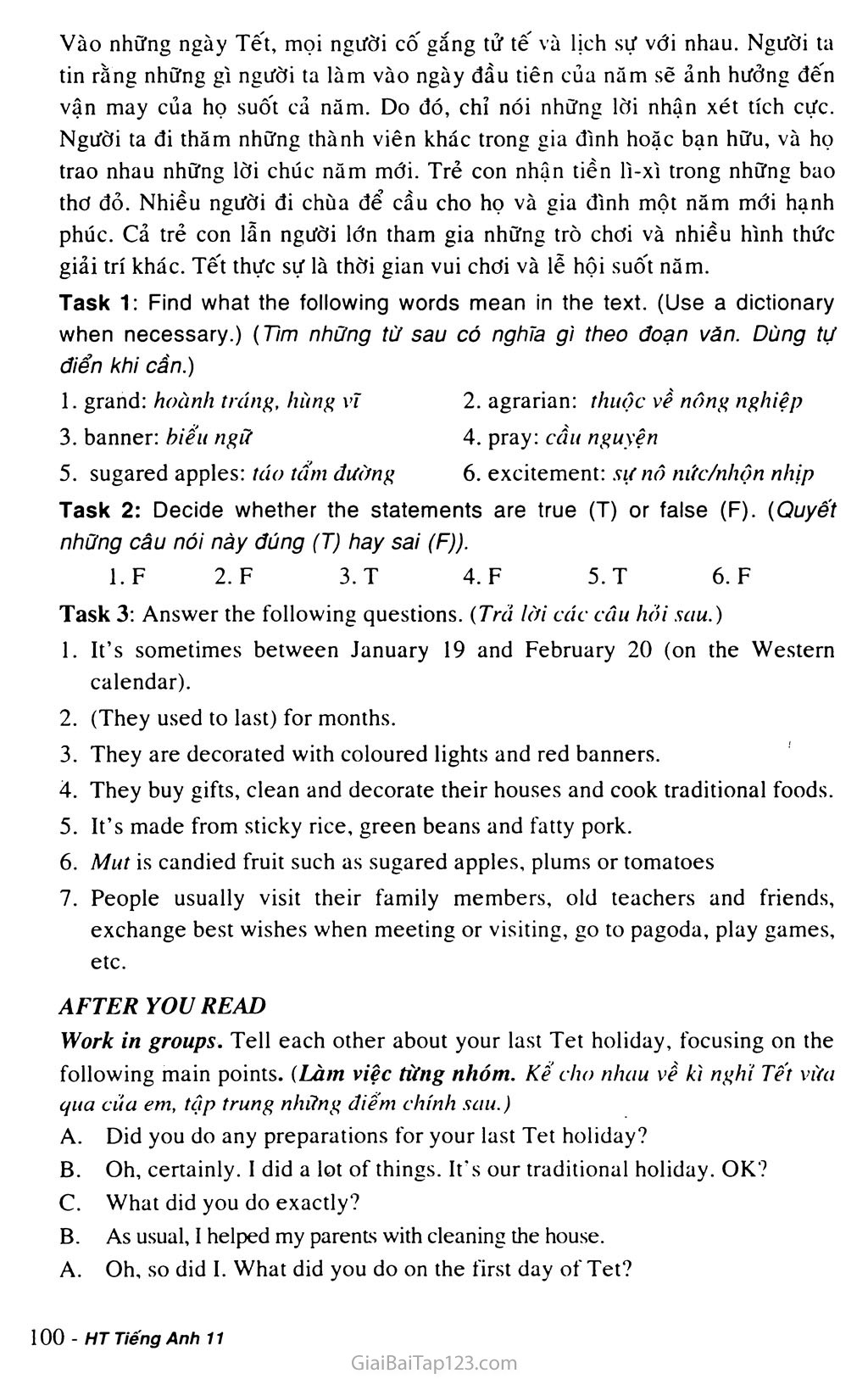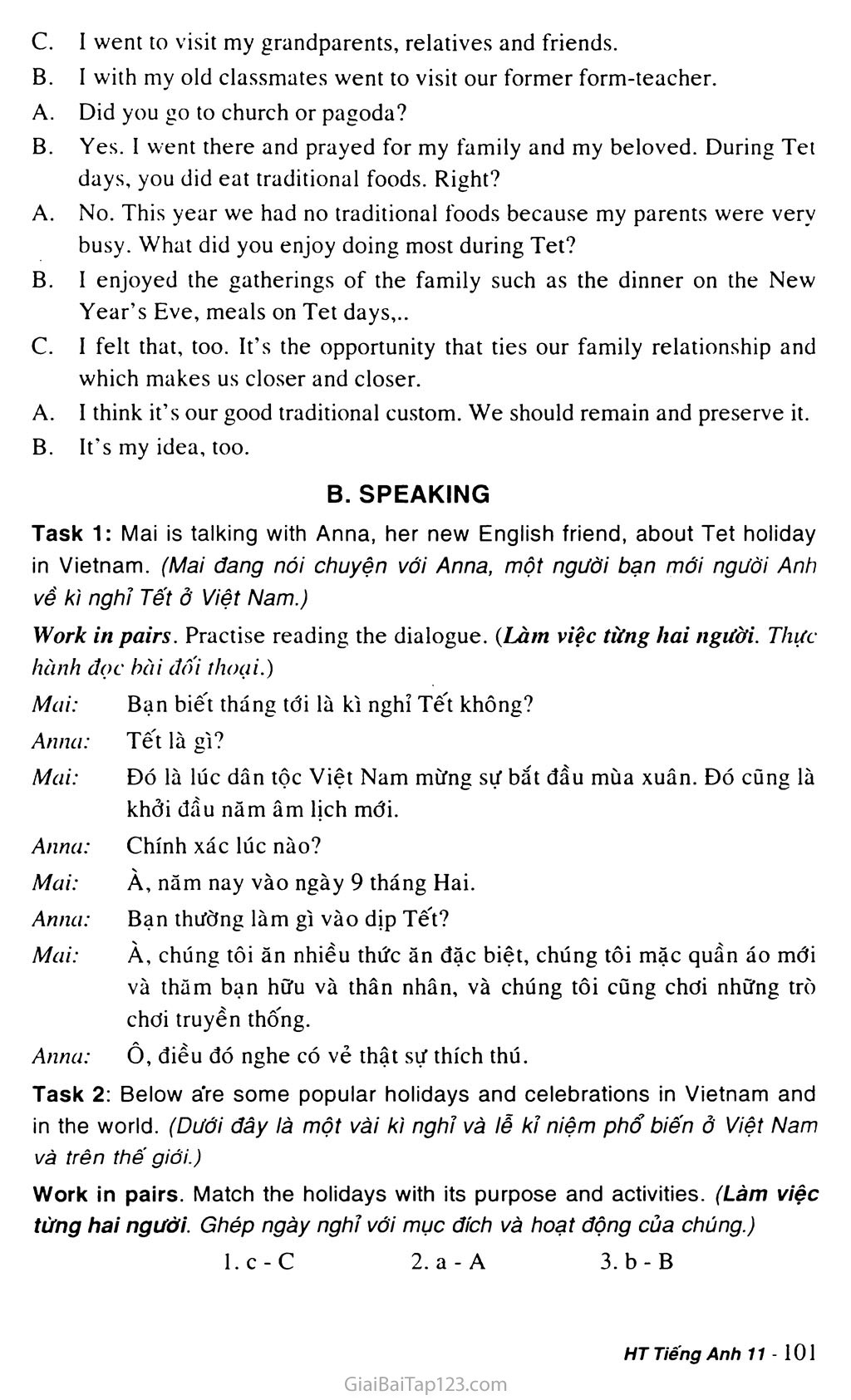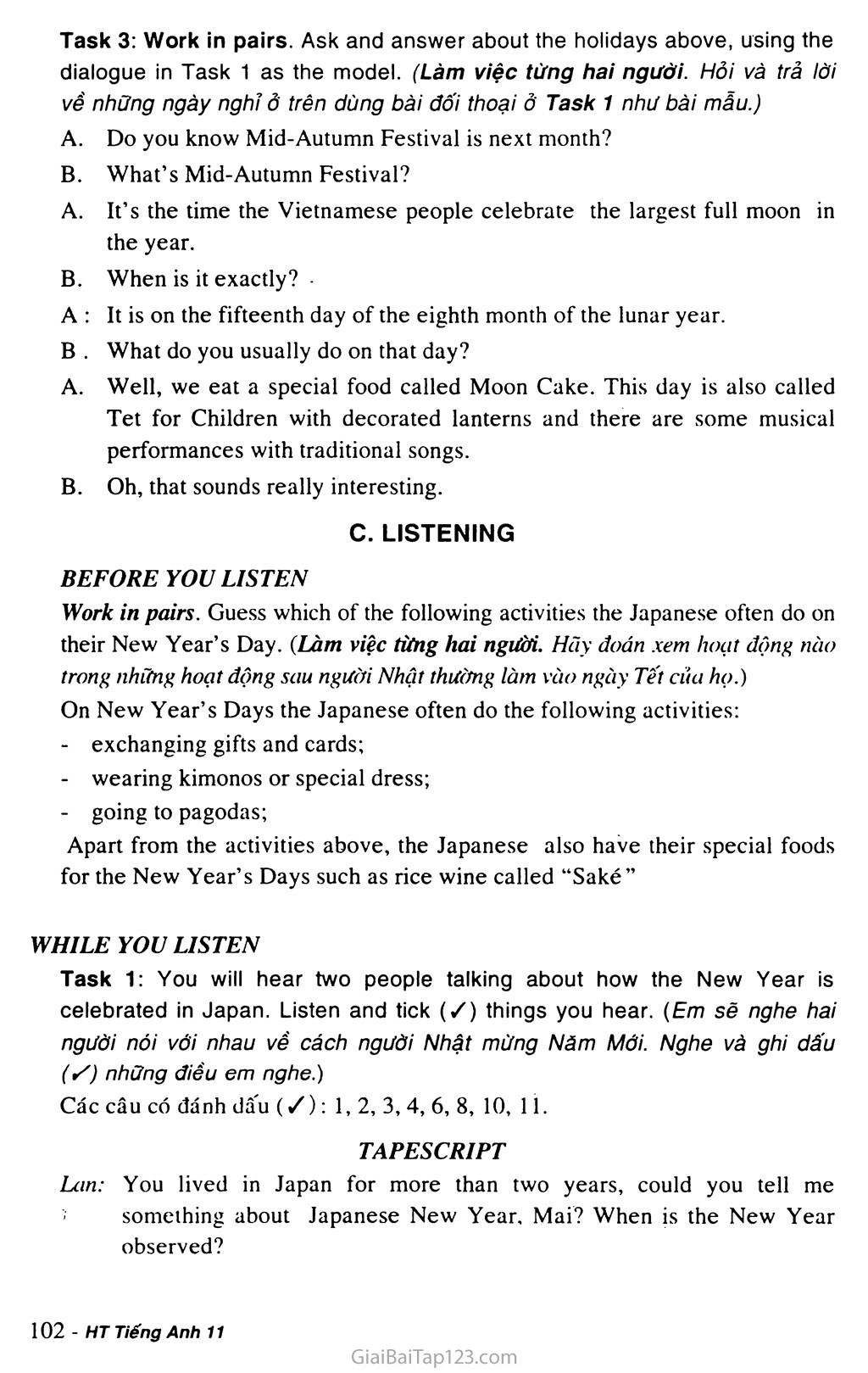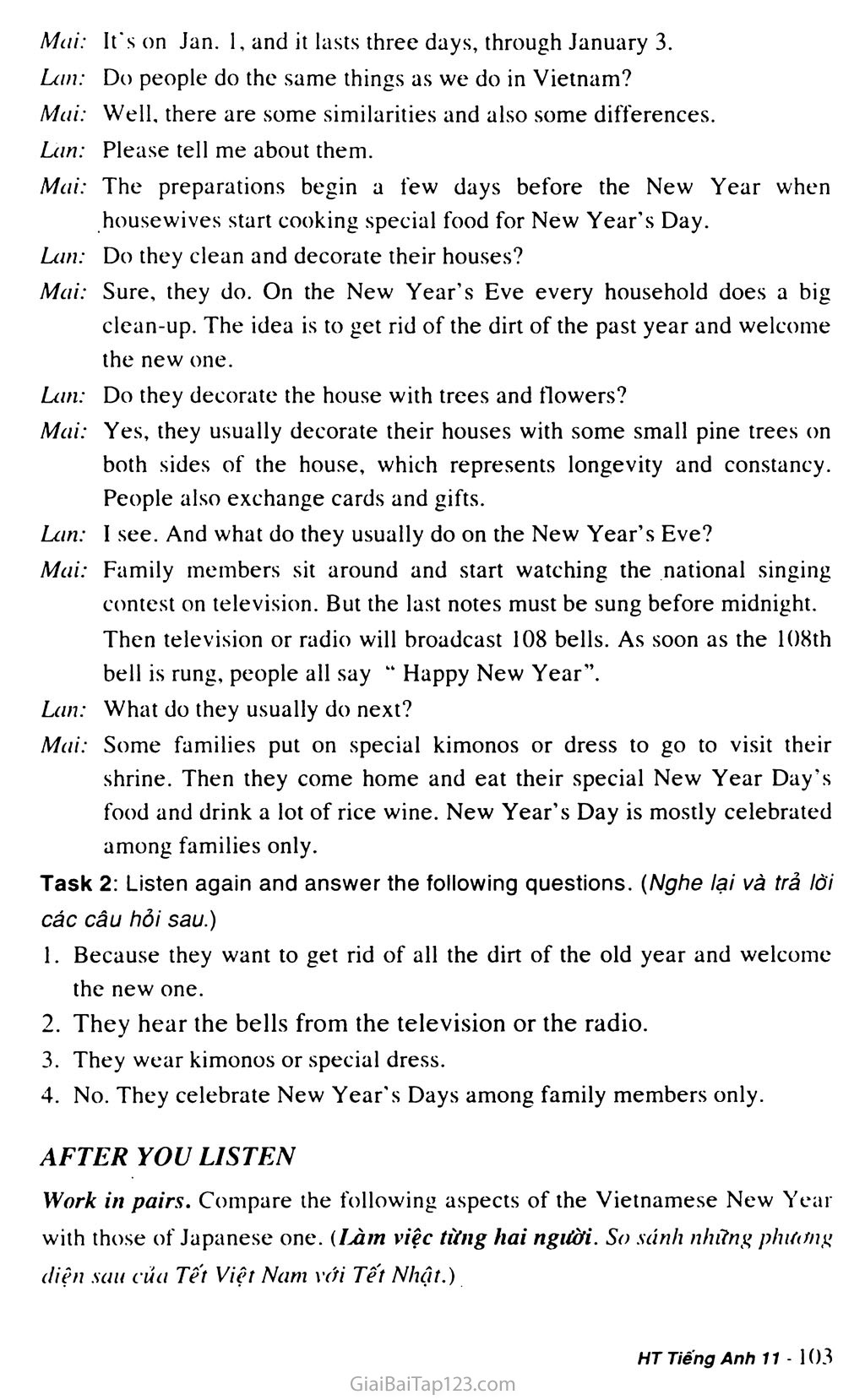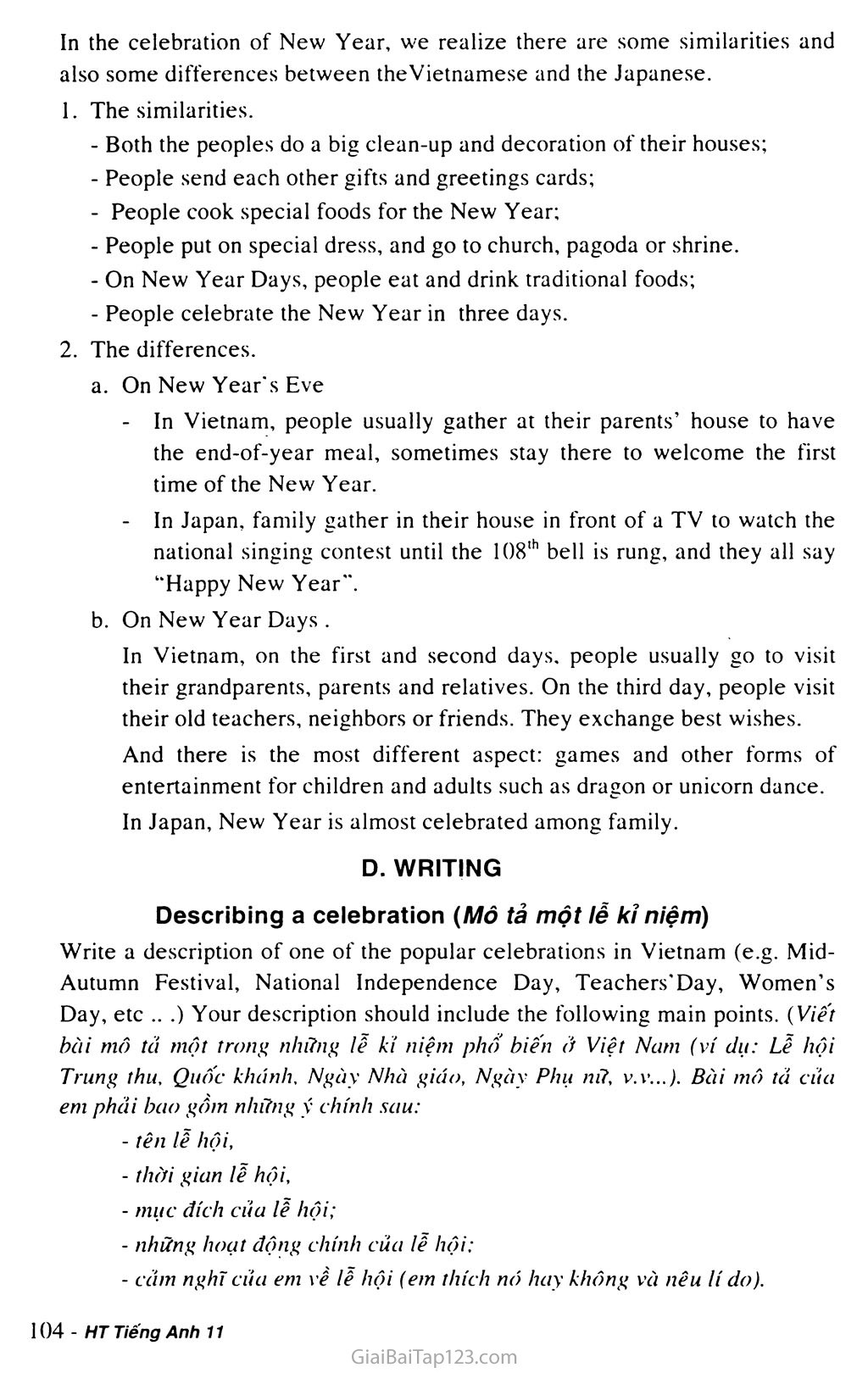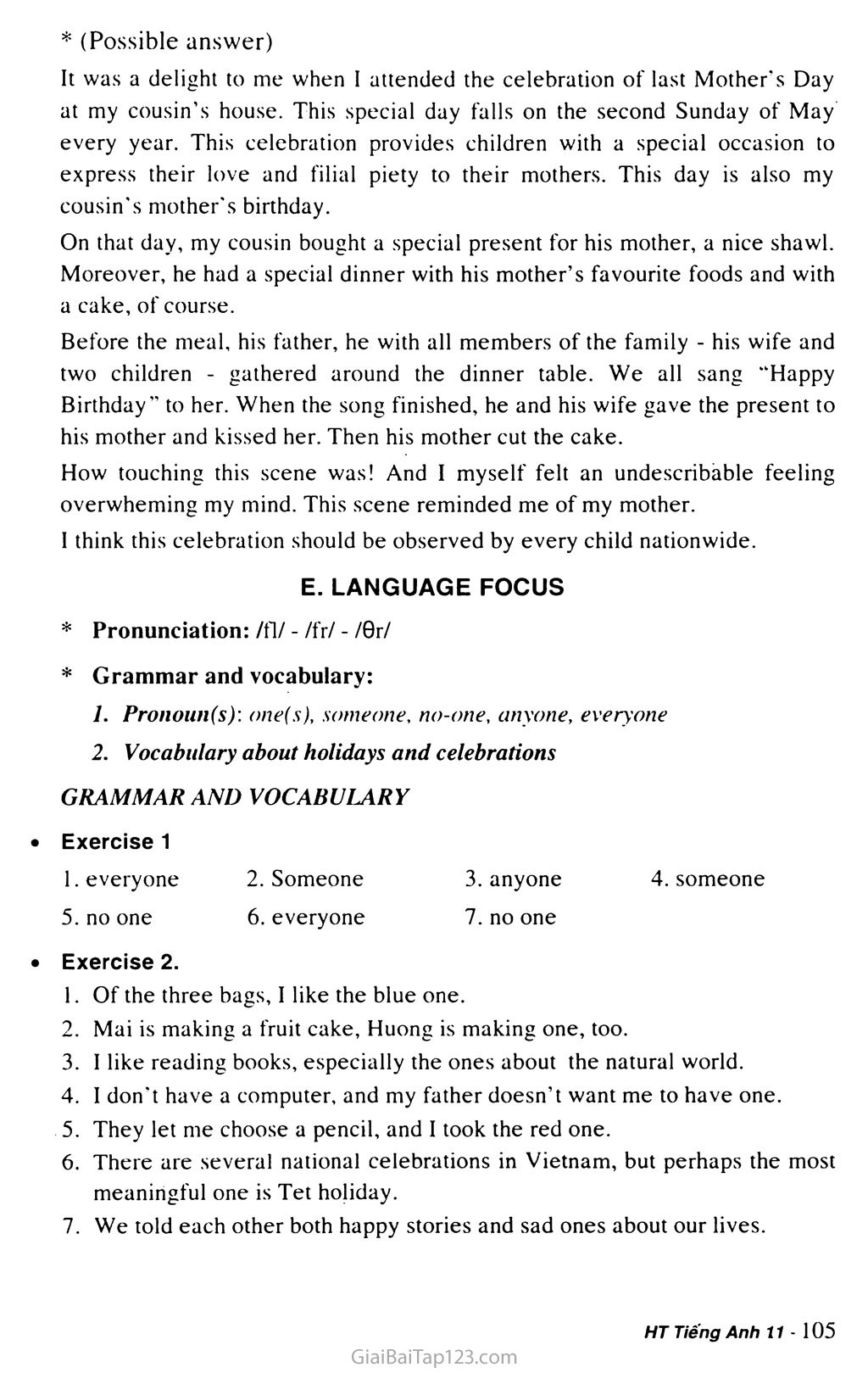Giải tiếng Anh lớp 11 Unit 8: CELEBRATIONS
Qftafla © CELEBRATIONS (Lễ kỉ niệm) VOCABULARY firework [ ‘faiaw.3:k] (n) : pháo bông grand I graend] (adj): splendid, very impressive: hoành tráng grandeur I'graenda] (rí) : sự hoành tráng/lộng lẫy; hùng mark [ma:k] (v): đánh dấu, ghi dấu agrarian [a’grearian] (adj) : thuộc nghề nông (n) : farmer: nhà Iiông/nông dân excitement [ik’saitmant] (n) : sự nhộn nhịp/sôi nổi excite [I’ksait] (v) : kích thích, kích động excited [ik’saitid] (adj): hào hứng/kích động build up [bild Ap I (v) : increase gradually: tích gom góp banner [‘basna] (n) : biểu ngữ blossom [‘blDsam] (n) : hoa (v) : ra hoa, nở hoa peach blossom [ ‘pÉựblDsam) (n) : hoa đào apricot I'aeprikDt] (n) : trái mơ apricot blossom (n) : hoa mai kumquat tree [kAmkwDt tri:] (n) : cây kim quất ripe [raip ] (adj) : chín (trái cây) * green (adj) : sống (trái cây) ripen [‘raipn] (v) : làm chín sticky rice [‘stiki ‘rais] (n) : (gạo) nếp pork I po.k] (n) : thịt heo fatty [ ‘fasti] (adj) : có nhiều mỡ plum IplAm] (n) : trái mận luck [lAk] (n) : vận, sự may rủi comment [‘kDment ] (n) : lời nhận xét/phê bình (v) : phê bình, bình luận lucky money [ 'lAki lmAni] (n) tiền lì-xì adult 1‘aedAlt] (n) người lớn pray (for) Iprei ] (V) cầu nguyện prayer 1 ‘preia] (n) lời cầu nguyện Thanksgiving ["Oseqks giviij] (n) lễ Tạ (ỉn (ở Mĩ) purpose [•p3:pas] (n) aim: mục đích purposeful [p3:posfl ] (adj ) : chủ V, có mục đích Valentine 1'vaelantain 1 (n) lễ Tình nhân harvest [ ’ha:vist] (n) mùa gặt, vụ thu hoạch (V) thu hoạch, gặt lúa harvester [ ’ha:vista] (n) thợ gặt mask [ma:sk] (n) mặt nụ (V) đeo mặt nạ, che dấu parade [ pa'reid] (n) cuộc diễu hành roast [rsust] (V) quay, (adj) : quay turkey [‘t3:ki] (n) : gà tây (lôi) longevity [ lDn’d3evatiJ (n) : tuổi thọ constancy [‘kDnstansi] (n) : tính kiên định, sự bất biến constant [‘kDnstant ] (adj): kiên định shrine [ Jrain] (n) : temple: đền thờ represent [repri’zent] (V): đại diện, tượng trưng cho representation [reprizen’teijn] (n) : sự dại diện/tượng trưng representative [repri’zentativ] (adj) : tượng trưng, tiêu biểu National Independence Day [‘naejnl indl’pendans del] (n) : lễ Quốc Khánh flag [ “flaeg] (n) : CỜ cauliflower [‘kDliflaua] (n): bông cải throat [Qraut] (n) : cuông họng keep away [ki:p a’wei] (V): Cất đi, dẹp đi turn up [t3:n ‘Ap] (V): arrive (at/in): đến, xuất hiện attract [ s' trsekt ] (V): thu hút, lôi cuốn attraction [a’traekjn] (n) : sự thu hút/quyến rũ attractive [a'traektiv] (adj) : hấp dẫn, quyến rũ spirit [‘spirit] (n) : tinh thần, thần linh, quỷ thần spiritual [‘spiritual] (adj) : thuộc tinh thần good spirit [god spirit] (n) : phúc thần ward off ]wo:d Df] (v) : tránli, ngăn ngừa evil [ ‘i:vl j (n) : điều ác, tai họa evil spirit [ ‘i:vl spirit] (n) : ác thần prince fprins] (n) : hoàng tử II. GRAMMAR A. ONE(S) 1. ONE(S): là đại từ nhân xưng (Personal pronoun), được dùng thay cho một danh từ được nói ở trước. ONE có thể ỏ dạng số nhiều: ONES, g.: A: Who’s the lecturer? (Diễn giả là ai?) B: The one in black suit with glasses. (Người mặc hộ vét đen đeo kính.) What other stamps do you like besides French ones? (Ngoài tem Pháp, hạn thích những tem gì khúc?) * Chúng ta có thể dùng từ “ONE(S)” hoặc bỏ. Trường hợp có thể bỏ. al.sau chí thị tính từ (demonstrative adjectives: this/these - that/those + noun). e.g: The shirts are very nice. I like this (one). (Những áo sơ mi rất đẹp. Tôi thích cúi này.) 32. sau “WHICH”. e.g.: We have a lot of flowers. Which (ones) do you like? (Chúng tôi có nhiều hoa. Bà thích những hông nào?) a3. sau “so sánh tuyệt đối” (superlatives), e.g.: These pictures are the best (ones). (Những bức tranh này là (những bức) đẹp nhất.) h. Trường hợp phai dùng “ONE(S)”. bl. sau tính từ . e.g.: 1T1 have an orange juice. A large one, please. (Tôi uống cam vắt. Vui lòng cho một li lân.) b?. sau mạo từ "THE”. e.g.: This computer is better than the one we had. (Máy tính này tốt hơn cái chúng tôi dã có.) 3. sau "EVERY". e.g.: This building has a lot of windows, but every one was broken. (Cat) ôc này ci) nhieu Clia số, nhưng mỗi cái dã hê.) b4. ONE thay cho " a + noun (danh từ)" e.g.: These oranges are very delicious. Do you want one? (Những trái cam này rất ngon. Bạn muôn một trái khôngN - one = an orange ONE: đại từ bất định (Indefinite pronoun), có nghĩa "any person": "bất kì ai", và bao gồm cả người nói, e.g.: One should obey the laws. (Người ta phải tuân luật pháp.) One must eat to live. (Mọi người phai ăn dể sống.) B. INDEFINITE PRONOUNS (Đại từ bất định) Dại từ bất định gồm: -one -body -thing some- someone somebody something any- anyone anybody anything 110- no-one nobody nothing every- everyone everybody everything Đại từ bât định luôn luôn ở số ít. e.g.: Someone is in the director's room. (Người nào dó trong phòng giám dốc.) If anyone calls, please take the message. (Nếu có ai gọi. vui lòng nhận lời nhắn.) NO-ONE; NONE No-one chỉ về người. e.g.: No-one has visited that shrine for ages. (Không ai thăm den th(t dó nhiều năm.) NONE: xác định một số lượng (a quantity) và đưực theo sau bởi "OE + phrase”, e.g: None of the thieves escaped from the capture. (Không một kẻ trộm nào trốn thoát khói cuộc lùng hắt.) None of candidates’ essays is chosen. (Không một hài văn nào cùa thí sinh dược chọn.) Chú ý: NONE có thể dùng cho người hoặc đồ vật. III. SOLUTIONS AND TRANSLATIONS (LỜI GIẢI VẢ BÀI DỊCH) A. READING BEFORE YOU READ Work in pairs. Look at the picture and discuss the questions. (Làm việc từng hai người. Nhìn hình và tháo luận các câu hỏi.) It’s the time of spring, the beginning time of a year in Vietnam. They’re having the first breakfast of the year and giving each other the best wishes of the year. There are flowers, fruit and some special food. Work in pairs. Tell your partner which of these activities you enjoy doing most at Tet. Are there any other things you like doing? (Làm việc từng hai người. Nói cho hạn cùng học của em hoạt dộng nào trong những hoạt động này em thích làm nhất vào dịp Tết? Có hoạt dộng nào khác em thích làm không'?) At Tet, I enjoy - receiving "lucky money”, decorating the house, going to the flower market, watching fireworks, visiting relatives, teachers and friends. WHILE YOU READ Read the text about Tet in Vietnam, and then do the tasks that follow. (Dọc đoạn vãn về Tết à Việt Nam. và sau đó làm bài tập theo sau.) Năm mới, hoặc Tết, là ngày lễ chính của Việt Nam. Đó là dịp quan trọng nhât và hoành tráng nhât trong năm, đôi khi rơi vào khoảng giữa ngày 19 tháng Một và ngày 20 tháng Hai theo lịch tây phương. Tết báo hiệu sự bắt đầu của mùa xuân, và đôi vơi nông dân, là sự khởi đầu của một năm mới. Việc chuẩn bị Tết và lễ kỉ niệm đã từng kéo dài suôt nhiều tháng, nhưng ngày nay, ngày lễ ngắn hơn nhiều. Tuy nhiên, nhiều sự nhộn nhịp vẫn còn xảy ra trước Tết. Đường phô' đưực trang trí với đèn màu và biểu ngữ đỏ. Các cửa hàng đầy ắp hàng hóa. Người ta bận rộn mua quà, lau chùi và trang hoàng nhà cửa và nâu những món ăn truyền thông. Vào dịp này nhà cửa thương được trang trí với cây cảnh và hoa. Hoa đào là hoa truyền thông ở miền bắc, trong khi hoa mai là hoa truyền thông ở miền nam. Cây kim quái với những quả chín văng Ối được ưa thích khắp mọi nơi trong nước. Một trong những món ăn đặc biệt nhái dịp Tết là bánh chưng, nó được làm từ nếp, đậu xanh và thịt heo mỡ. Mứt, trái cây làm kẹo như táo tẩm đường, mận hoặc cà chua cũng rất phổ biến. Vào những ngày Tết, mọi người cố gắng tử tế và lịch sự với nhau, Người ta tin rằng những gì người ta làm vào ngày đầu tiên của năm sẽ ảnh hưỏng đến vận may của họ suôi cả năm. Do đó, chỉ nói những lời nhận xét tích cực. Người ta đi thăm những thành viên khác trong gia đình hoặc bạn hữu, và họ trao nhau những lời chúc năm mới. Trẻ con nhận tiền lì-xì trong những bao thơ đỏ. Nhiều người đi chùa để cầu cho họ và gia đình một năm mới hạnh phúc. Cả trẻ con lẫn người lớn tham gia những trò chơi và nhiều hình thức giải trí khác. Tết thực sự là thời gian vui chơi và lễ hội suốt năm. Task 1: Find what the following words mean in the text. (Use a dictionary when necessary.) (77m những từ sau có nghĩa gì theo đoạn văn. Dùng tự điển khi cần.) grand: hoảnh tráng, hùng vĩ 2. agrarian: thuộc về nông nghiệp 3. banner: biểu ngữ 4. pray: cầu nguyện 5. sugared apples: táo tẩm đường 6. excitement: sự nô nức/nhộn nhịp Task 2: Decide whether the statements are true (T) or false (F). (Quyết những câu nói này đúng (T) hay sai (F)). F 2. F 3.T 4. F 5. T 6. F Task 3: Answer the following questions. (Trả lời cúc câu hoi sau.) It’s sometimes between January 19 and February 20 (on the Western calendar). (They used to last) for months. They are decorated with coloured lights and red banners. They buy gifts, clean and decorate their houses and cook traditional foods. It’s made from sticky rice, green beans and fatty pork. Mut is candied fruit such as sugared apples, plums or tomatoes People usually visit their family members, old teachers and friends, exchange best wishes when meeting or visiting, go to pagoda, play games, etc. AFTER YOU READ Work in groups. Tell each other about your last Tet holiday, focusing on the following main points. (Làm việc từng nhóm. Kể cho nhau về kì nghỉ Tết vừa qua của em, tập trung những điếm chính sau.) Did you do any preparations for your last Tet holiday? Oh, certainly. I did a lot of things. It's our traditional holiday. OK? What did you do exactly? B. As usual, I helped my parents with cleaning the house. A. Oh, so did I. What did you do on the first day of Tet? c. I went to visit my grandparents, relatives and friends. B. I with my old classmates went to visit our former form-teacher. Did you go to church or pagoda? Yes. I went there and prayed for my family and my beloved. During Tet days, you did eat traditional foods. Right? No. This year we had no traditional foods because my parents were very busy. What did you enjoy doing most during Tet? I enjoyed the gatherings of the family such as the dinner on the New Year’s Eve, meals on Tet days,.. c. 1 felt that, too. It’s the opportunity that ties our family relationship and which makes US closer and closer. I think it’s our good traditional custom. We should remain and preserve it. It’s my idea, too. B. SPEAKING Task 1: Mai is talking with Anna, her new English friend, about Tet holiday in Vietnam. (Mai đang nói chuyện vói Anna, một người bạn mới ngưỏi Anh về kì nghỉ Tết ở Việt Nam.) Work in pairs. Practise reading the dialogue. (Làm việc từng hai người. Thực hành đọc hài đối thoại.) Mai: Bạn biết tháng tới là kì nghỉ Tết không? Anna: Tết là gì? Mai: Đó là lúc dân tộc Việt Nam mừng sự bắt đầu mùa xuân. Đó cũng là khởi đầu năm âm lịch mới. Anna: Chính xác lúc nào? Mai: À, năm nay vào ngày 9 tháng Hai. Anna: Bạn thường làm gì vào dịp Tết? Mai: À, chúng tôi ăn nhiều thức ăn đặc biệt, chúng tôi mặc quần áo mới và thăm bạn hữu và thân nhân, và chúng tôi cũng chơi những trò chơi truyền thông. Anna: Ô, điều đó nghe có vẻ thật sự thích thú. Task 2: Below a’re some popular holidays and celebrations in Vietnam and in the world. (Dưới đày là một vài kì nghĩ và lễ kỉ niệm phổ biến ở Việt Nam và trên thế giới.) Work in pairs. Match the holidays with its purpose and activities. (Làm việc từng hai người. Ghép ngày nghỉ với mục đích và hoạt động của chúng.) c-C 2. a - A 3. b - B Task 3: Work in pairs. Ask and answer about the holidays above, using the dialogue in Task 1 as the model. (Làm việc từng hai người. Hỏi và trả lời về những ngày nghỉ ỗ trên dùng bài đối thoại ở Task 1 như bài mẫu.) Do you know Mid-Autumn Festival is next month? What’s Mid-Autumn Festival? It’s the time the Vietnamese people celebrate the largest full moon in the year. When is it exactly? . A : It is on the fifteenth day of the eighth month of the lunar year. B . What do you usually do on that day? Well, we eat a special food called Moon Cake. This day is also called Tet for Children with decorated lanterns and there are some musical performances with traditional songs. Oh, that sounds really interesting. LISTENING BEFORE YOU LISTEN Work in pairs. Guess which of the following activities the Japanese often do on their New Year’s Day. (Làm việc từng hai người. Hãy đoán xem hoạt động nào trong những hoạt động sau người Nhật thường làm vào ngày Tết của họ.) On New Year’s Days the Japanese often do the following activities: exchanging gifts and cards; wearing kimonos or special dress; going to pagodas; Apart from the activities above, the Japanese also have their special foods for the New Year’s Days such as rice wine called “Sake” WHILE YOU LISTEN Task 1: You will hear two people talking about how the New Year is celebrated in Japan. Listen and tick (/) things you hear. (Em sẽ nghe hai người nói vôi nhau về cách người Nhật mừng Năm Mới. Nghe và ghi dấu (S) những điều em nghe.) Các câu có đánh dâ'u (/): 1, 2, 3, 4, 6, 8, 10, 11. TAPESCRIPT Lan: You lived in Japan for more than two years, could you tell me something about Japanese New Year. Mai? When is the New Year observed? Mai: It’s on Jan. 1, and it lasts three days, through January 3. Lan: Do people do the same things as we do in Vietnam? Mai: Well, there are some similarities and also some differences. Lan: Please tell me about them. A/izz; The preparations begin a few days before the New Year when housewives start cooking special food for New Year's Day. Lan: Do they clean and decorate their houses? Mai: Sure, they do. On the New Year’s Eve every household does a big clean-up. The idea is to get rid of the dirt of the past year and welcome the new one. Lan: Do they decorate the house with trees and flowers? Mai: Yes, they usually decorate their houses with some small pine trees on both sides of the house, which represents longevity and constancy. People also exchange cards and gifts. Lan: 1 see. And what do they usually do on the New Year’s Eve? Mai: Family members sit around and start watching the national singing contest on television. But the last notes must be sung before midnight. Then television or radio will broadcast 108 bells. As soon as the 108th bell is rung, people all say “ Happy New Year”. Lan: What do they usually do next? Mai: Some families put on special kimonos or dress to go to visit their shrine. Then they come home and eat their special New Year Day’s food and drink a lot of rice wine. New Year’s Day is mostly celebrated among families only. Task 2: Listen again and answer the following questions. (Nghe lại và trả lỏi các câu hỏi sau.) Because they want to get rid of all the dirt of the old year and welcome the new one. They hear the bells from the television or the radio. They wear kimonos or special dress. No. They celebrate New Year's Days among family members only. AFTER YOU LISTEN Work in pairs. Compare the following aspects of the Vietnamese New Year with those of Japanese one. (iMin việc từng hai người. Sa sánh những phương diện san cửa Tết Việt Nam với Tết Nhật.) In the celebration of New Year, we realize there are some similarities and also some differences between the Vietnamese and the Japanese. The similarities. Both the peoples do a big clean-up and decoration of their houses; People send each other gifts and greetings cards; People cook special foods for the New Year; People put on special dress, and go to church, pagoda or shrine. On New Year Days, people eat and drink traditional foods; People celebrate the New Year in three days. The differences. On New Year's Eve In Vietnam, people usually gather at their parents’ house to have the end-of-year meal, sometimes stay there to welcome the first time of the New Year. In Japan, family gather in their house in front of a TV to watch the national singing contest until the 108'h bell is rung, and they all say “Happy New Year", On New Year Days . In Vietnam, on the first and second days, people usually go to visit their grandparents, parents and relatives. On the third day, people visit their old teachers, neighbors or friends. They exchange best wishes. And there is the most different aspect: games and other forms of entertainment for children and adults such as dragon or unicorn dance. In Japan, New Year is almost celebrated among family. D. WRITING Describing a celebration (Mô tả một lễ kỉ niệm) Write a description of one of the popular celebrations in Vietnam (e.g. Mid- Autumn Festival, National Independence Day, Teachers’Day, Women’s Day, etc .. .) Your description should include the following main points. (Viết bùi mô tà một trong những lễ kí niệm phố biến ở Việt Nam (ví dụ: Lễ hội Trung thu, Quốc khánh. Ngày Nhà giáo, Ngày Phụ mì, V.V..J. Bài mô tả ciia em phdi bao gồm những ý chính sau: tên lễ hội, thời gian lễ hội, mục đích của lễ hội; những hoạt động chính của lễ hội; câm nghĩ cua em về lễ hội (em thích nó hay không và nêu lí do). (Possible answer) It was a delight to me when I attended the celebration of last Mother’s Day at my cousin’s house. This special day falls on the second Sunday of May every year. This celebration provides children with a special occasion to express their love and filial piety to their mothers. This day is also my cousin’s mother's birthday. On that day, my cousin bought a special present for his mother, a nice shawl. Moreover, he had a special dinner with his mother’s favourite foods and with a cake, of course. Before the meal, his father, he with all members of the family - his wife and two children - gathered around the dinner table. We all sang “Happy Birthday" to her. When the song finished, he and his wife gave the present to his mother and kissed her. Then his mother cut the cake. How touching this scene was! And I myself felt an undescribable feeling overwheming my mind. This scene reminded me of my mother. 1 think this celebration should be observed by every child nationwide. E. LANGUAGE FOCUS Pronunciation: /fl/ - /fr/ - /0r/ Grammar and vocabulary: Pronoun(s): one(s), someone, no-one, anyone, everyone Vocabulary about holidays and celebrations GRAMMAR AND VOCABULARY Exercise 1 1. everyone 2. Someone 3. anyone 4. someone 5. no one 6. everyone 7. no one Exercise 2. Of the three bags, I like the blue one. Mai is making a fruit cake, Huong is making one, too. I like reading books, especially the ones about the natural world. I don’t have a computer, and my father doesn’t want me to have one. They let me choose a pencil, and I took the red one. There are several national celebrations in Vietnam, but perhaps the most meaningful one is Tet holiday. We told each other both happy stories and sad ones about our lives. • Exercise 3 1. traditional 2. grand 3. gifts 4. celebrating polite 6. good luck 7. Excitement

